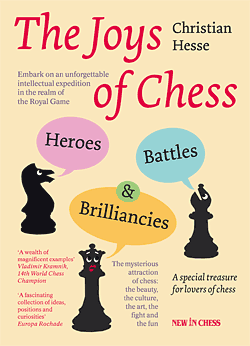Retreats of genius
By Prof. Christian Hesse
Sometimes you have to move backward to get a step forward.
Amar Bose
We shall show some examples of retreats that are not only good, but even bordering on the brilliant. Moves with a paradoxical relationship between expression, function and effect. All in all, moves which run counter to the principle of ‘form follows function’. A classic prime example of this is:

[Event "Dresden"] [Site "Dresden"] [Date "1926.04.09"] [Round "5"] [White "Nimzowitsch, Aaron"] [Black "Rubinstein, Akiba"] [Result "1-0"] [ECO "A34"] [PlyCount "91"] [EventDate "1926.04.??"] [EventRounds "9"] [EventCountry "GER"] [Source "ChessBase"] [SourceDate "1999.07.01"] 1. c4 c5 2. Nf3 Nf6 3. Nc3 d5 4. cxd5 Nxd5 5. e4 Nb4 6. Bc4 e6 7. O-O N8c6 8. d3 Nd4 9. Nxd4 cxd4 10. Ne2 a6 11. Ng3 Bd6 12. f4 O-O 13. Qf3 Kh8 14. Bd2 f5 15. Rae1 Nc6 16. Re2 Qc7 17. exf5 exf5 {[#]White now baffled his opponent with the amazing retreat} 18. Nh1 $3 {This move can be interpreted as extremely attacking and it represents the start of a long journey for the knight. In his book, Les Prix de Beauté aux Échecs, Francois Le Lionnais describes it as the strongest attacking move ever played ('Le plus fort coup d'attaque du monde'). A backward attack! Fritz too, after some five minutes thinking time, pronounces in favour of this move compared to the homely} (18. Rfe1 {which grants White a slight advantage.}) 18... Bd7 19. Nf2 Rae8 20. Rfe1 Rxe2 21. Rxe2 Nd8 ({Not} 21... Re8 {on account of} 22. Rxe8+ Bxe8 23. Qd5 Ne7 24. Qxd4 { and White has the superior position.}) 22. Nh3 Bc6 ({Here too, not} 22... Re8 { because of} 23. Rxe8+ Bxe8 24. Qd5 Bf7 25. Qxf5 {with an advantage for White. So Black cannot extend his influence to the e-file. From White's point of view, a case of a file which defends itself and which the black rook cannot enter.}) 23. Qh5 g6 24. Qh4 Kg7 25. Qf2 $1 Bc5 26. b4 Bb6 27. Qh4 (27. Qe1 $1 {The text move weakens the e-file and robs it of its capacity for self-defence.}) 27... Re8 $1 28. Re5 Nf7 $6 {White now spotted the possibility of achieving a winning position by force:} 29. Bxf7 Qxf7 30. Ng5 Qg8 31. Rxe8 Bxe8 32. Qe1 $1 {In spite of the paucity of material, Black is obliged to urgently consider the possibility of mate. He tried to wrest the initiative from White with a sort of partisan-like battle:} Bc6 ({After} 32... Kh6 33. Ne6 {is unpleasant.}) (32... Kf6 {is followed by} 33. Qe5#) ({After} 32... h6 {there is the winning line:} 33. Qe5+ Kf8 34. Qf6+ Bf7 35. b5 a5 36. Qd6+ Ke8 37. Qb8+ Ke7 38. Qxb7+ {etc. +–}) (32... Kf8 {is met by the decisive} 33. Qe5 Qxa2 34. Nxh7+ Kg8 35. Qe7 Bf7 36. Nf6+ Kg7 37. Nd7 Qe6 38. Qxe6 Bxe6 39. Nxb6) 33. Qe7+ Kh8 34. b5 Qg7 (34... axb5 {fails to} 35. Ne6 h5 36. Qf6+ Kh7 37. Bb4 {and mates.}) 35. Qxg7+ Kxg7 36. bxc6 bxc6 37. Nf3 c5 38. Ne5 Bc7 39. Nc4 Kf7 40. g3 Bd8 41. Ba5 Be7 42. Bc7 Ke6 43. Nb6 h6 44. h4 g5 45. h5 g4 46. Be5 1-0
There was an even more striking employment of our theme in the next game. At the time both players were just 13 years old. Yet, because of brilliant and extraordinary play, White turned their encounter into an absolute chess rarity. After 15 moves the two teenagers had worked themselves into this position:

[Event "USSR Junior Championship"] [Site "?"] [Date "1957.??.??"] [Round "?"] [White "Dzindzichashvili, Roman"] [Black "Zakharov, Alexander"] [Result "1-0"] [ECO "E00"] [SetUp "1"] [FEN "r3kb1r/pp3ppp/2n1p3/1B2P1B1/3N4/2Nb4/Pn3PPP/R4RK1 w - - 0 16"] [PlyCount "7"] [EventDate "1957.??.??"] {White is faced with the question as to what was the most principled continuation. With an offhand sacrifice of the exchange, he set up the conditions for a piece of action, unparalleled in the history of chess, which led to an exquisite final position:} 16. Nxc6 Bxf1 {After that White had thought up a retreat which is well worth seeing:} 17. Bxf1 $1 ({With this, White changes into reverse gear. Moving sideways with} 17. Rxf1 $2 {would be met with} a6 $1) 17... bxc6 18. Bc1 $1 Ba3 ({A better try was} 18... Rb8 $1 19. Rb1 Ba3 20. Nd1 $1 {0-0 Then things could have continued with Rxb2 Bxb2 Nxb2 with an unclear position.}) 19. Nb1 $1 {[%cal Gc3b1] [#]And when he saw this clincher, Black resigned. All the moves towards the rear by white pieces have been objectively the best. After the possible continuation} (19. Nb1 Bc5 20. Bxb2 Rd8 21. Bc3 Ke7 22. Nd2 Bd4 23. Bxd4 {White's advantage is worth roughly one pawn. Actually this was a bit early to throw in the towel, but perhaps Zakharov had been a bit unnerved by the vehemence of his opponent's strategy. Such a position remains in one's memory and belongs in the picture book of chess. White has ordered all his forces back to barracks and caused Black to resign merely on account of the effect of his remaining pieces in their starting positions. Zero growth as a programme. With an execution one should savour.}) 1-0
A treat ment of the retreat motif in the form of a problem can be found in the following amazing problem:

[Event "?"] [Site "?"] [Date "1889.??.??"] [Round "?"] [White "Taverner, Thomas"] [Black "Mate in two moves"] [Result "1-0"] [SetUp "1"] [FEN "3brrb1/2N4B/8/2p4Q/2p2k2/5P2/4P1KR/2N2RB1 w - - 0 1"] [PlyCount "3"] [EventDate "1889.??.??"] {The key} 1. Rh1 $3 {is not easy to find for a human being. An extraordinarily surprising retreat into a blind spot, which makes a strong impression on us. Strangely, there is no antidote to this move, because Black very suddenly finds himself in zugzwang. He may have at his disposition a total of 19 possible replies. But White has a mate ready after every one of them, e.g.} Re5 (1... Bxh7 2. Nd5#) (1... Be7 2. e3#) (1... Bf6 2. Qf5#) (1... Bg5 2. Qh2#) ( 1... Bh4 2. Rxh4#) (1... Re4 2. fxe4#) (1... Re3 2. Bh2#) (1... Rxe2+ 2. Nxe2#) (1... c3 2. Nd3#) 2. Qg4# $1 {The double exclamation mark behind the key move emphasises the uniqueness of the mating move. One small step backwards for the rook was the key. A nice piece of chess.} 1-0
An other example of the triumph of the strategy of retreat is offered in this problem:

[Event "?"] [Site "?"] [Date "1935.??.??"] [Round "?"] [White "Ernst"] [Black "Mate in four moves"] [Result "1-0"] [SetUp "1"] [FEN "qk6/rb1Bp3/p3Pp2/P2N1P2/3B3p/2PRN2p/4K2P/1R6 w - - 0 1"] [PlyCount "7"] [EventDate "1935.??.??"] {Black is completely paralysed. Were it his turn, there would be no piece he could move. This lack of mobility seems to hold out the hope of stalemate as a saving grace for him. For that reason, White cannot take direct action against the black king, but he must start a finely tuned backwards-sidewards movement on a wide front. The solution is} 1. Ng2 $1 {This provides Black with a move and threatens 2.Be3 and then 3.Bf4.} hxg2 (1... -- 2. Be3 {[%cal Ge3f4,Rf4b8]}) 2. Rg3 $1 hxg3 3. Bg1 $1 {This loads a piece on the square in front of the black pawns and sets up a zuzwang here too. So} gxh2 {and all is brought to an end with the quite prosaic} 4. Bxh2# 1-0
As the high point of our chapter, we have a masterpiece of the problem composer’s art, which begins with a mysterious-looking, long and thus uncommonly fascinating sequence of backward moves as White retreats from the object of his desire, Black’s king.

[Event "?"] [Site "?"] [Date "1976.??.??"] [Round "?"] [White "Giegold, Fritz"] [Black "Mate in six moves"] [Result "1-0"] [SetUp "1"] [FEN "n1N3br/2p1Bpkr/1pP2R1b/pP1p1PpR/Pp4P1/1P6/1K1P4/8 w - - 0 1"] [PlyCount "11"] [EventDate "1976.??.??"] {Apart from his d-pawn Black is completely walled in. So White has no more than two moves to lift the blockade, in order to prevent stalemate. The winning method consists of leaving the f6 rook unprotected at the appropriate moment in order to force ...Kxf6 and then to deliver mate with the bishop along the a1-h8 diagonal. But until that happens, the white bishop has no sensible moves. The execution of the plan starts with the puzzling move} 1. Rh1 $3 {[%cal Gh5h1,Gh1a1,Ga1a3] and this is just the beginning of a breathtaking series of retreats.} d4 2. Ra1 $3 {Even more mysterious. Why this when the target is the black king? It only later becomes clear why the rook has to go to a1. Black has no choice but to play the only move available to him:} d3 { The threat of stalemate should be lifted now. That is done by} 3. Ra3 $1 {We suddenly understand the whole rook manœuvre. White cures Black's paralysis and opens up the diagonal for his own bishop.} bxa3+ 4. Ka1 {The king retreats too.} a2 {The end is nigh:} 5. Ba3 $1 Kxf6 {and} 6. Bb2# {The white pieces have all headed back towards their own king, but the object of their desires and the actual battlefield are in the opposite corner of the board.} 1-0
A more than worthy way to finish the chapter.
Christian Hesse holds a Ph.D. from Harvard University and was on the faculty of the University of California at Berkeley until 1991. Since then he is Professor of Mathematics at the University of Stuttgart (Germany). Subsequently he has been a visiting researcher and invited lecturer at universities around the world, ranging from the Australian National University, Canberra, to the University of Concepcion, Chile. Recently he authored “Expeditionen in die Schachwelt” (Expeditions into the world of chess, ISBN 3-935748-14-0), a collection of about 100 essays that the Viennese newspaper Der Standard called “one of the most intellectually scintillating and recommendable books on chess ever written.”

Christian Hesseis married and has a fourteen-year-old daughter and a ten-year-old son. He lives in Mannheim and likes Voltaire's reply to the complaint: ”Life is hard” – “Compared to what?”.
 The Joys of Chess is an unforgettable intellectual expedition to the remotest corners of the Royal Game. En route, intriguing thought experiments, strange insights and hilarious jokes will offer vistas you have never seen before.
The Joys of Chess is an unforgettable intellectual expedition to the remotest corners of the Royal Game. En route, intriguing thought experiments, strange insights and hilarious jokes will offer vistas you have never seen before.
The beauty, the struggle, the culture, the fun, the art and the heroism of chess – you will find them all in this sparkling book that will give you many hours of intense joy.
Christian Hesse is a Harvard-trained professor of Mathematics who has taught at the University of California, Berkeley (USA), and since 1991 at the University of Stuttgart. He has written a textbook called 'Angewandte Wahrscheinlichkeitstheorie'.
Chess and literature are his main hobbies, and he also likes fitness and boxing. His heroes are the ones who fall to the bottom and rise again, fall and rise again…
From the foreword by by Ex-World Champion Vishy Anand: "A rich compendium of spectacular highlights and defining moments from chess history: fantastic moves, beautiful combinations, historical blunders, captivating stories, and all this embedded into a plentitude of quick-witted ideas and contemplations as food for thought."




















 The Joys of Chess is an unforgettable intellectual expedition to the remotest corners of the Royal Game. En route, intriguing thought experiments, strange insights and hilarious jokes will offer vistas you have never seen before.
The Joys of Chess is an unforgettable intellectual expedition to the remotest corners of the Royal Game. En route, intriguing thought experiments, strange insights and hilarious jokes will offer vistas you have never seen before.




